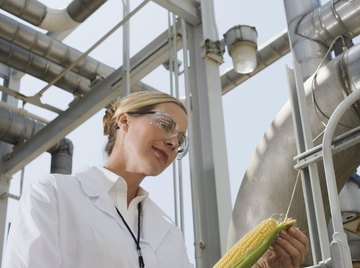
Ethanol, or ethyl alcohol, and methanol, or methyl alcohol, are renewable fuel sources, made from plant-based materials ranging from corn and sugar cane to agricultural and timber waste. They are highly flammable and volatile substances. Outside of carefully controlled environments, such as laboratories, the burning temperature and other characteristics of these materials vary slightly depending on impurities and other factors; when compared to other fuels, they have relatively similar peak flame and flash point temperatures.
Ethanol
Ethanol is a very common form of alcohol. It is an organic compound made of carbon, hydrogen and oxygen (as a derivative of hydrocarbons). It is often known as potable alcohol, as it is the primary component in recreationally consumed alcohol found in beer, wine, and hard alcohols (like whiskey or Everclear). It is also the primary component in many types of rubbing alcohol and hand sanitizer.
When used as a renewable fuel source, Ethanol is a clean burning fuel – meaning that it leaves very little residual pollution after its combustion reaction takes place. Other fuels such as natural gas are well known for burning clean.
Methanol
Methanol, also called wood alcohol, is extremely similar to ethanol in chemical structure and properties. However it differs in many smaller, more chemically fundamental ways. While ethanol is potable (meaning people can safely drink it), methanol is actually poisonous. Methanol is used as an additive to many commercial products that contain ethanol to create denatured alcohol, which is no longer suitable for human consumption. It also causes methanol poisoning which discourages recreational usage of hand sanitizer or similar products.
Methanol can be made in a variety of ways, including extraction from organic materials (like wood) and oxidation of methane gas, a chemically similar compound.
Too Hot to Handle
When alcohols burn they use oxygen to undergo a combustion process. This results in the emission of carbon dioxide, water, and heat energy.
Tips
When ethanol burns, it creates a blue flame, and when methanol burns it results in a yellow flame color.
The peak flame temperature of pure ethanol is 1,920 degrees Celsius (3,488 degrees Fahrenheit), while the peak flame temperature of pure methanol is 1,870 degrees Celsius (3,398 degrees Fahrenheit). Ethanol also has a higher flash point than methanol: about 14 degrees Celsius (57.2 degrees Fahrenheit) to methanol's 11-degree Celsius (51.8 degrees Fahrenheit) flash point. A volatile liquid's flash point is the lowest temperature at which it can vaporize to form an ignitable mixture in the area. The autoignition temperature, the minimum temperature at which the material ignites without a flame or spark present (e.g. when in contact with a hot surface), however, is higher for methanol than ethanol.
Uses of Different Alcohols
Ethanol fuel and methanol fuel are used as cleaner alternatives to oil and gasoline. These compounds are used to create many commercial products like hand sanitizer. There are other types of alcohol that are commonly used for alcohol stoves, chemical processes, or other situations in chemistry and combustion requiring energy dense hydrocarbons.
Isopropyl alcohol (also known as isopropanol) can also be used to denature alcohol, and it is often the primary component in rubbing alcohol. Isopropyl alcohol is also often used as an alcohol fuel for home use purposes. Camping stoves and backpacking stoves often use rubbing alcohol as fuel because it is a very common and compact fuel source.
Butane, acetone, propane, and hexane are other types of alcohol. Many of them share a common ketone functional group which consists of carbon connected to two other compounds or elements.
References
Resources
About the Author
Angela Ryczkowski is a professional writer who has served as a greenhouse manager and certified wildland firefighter. She holds a Bachelor of Arts in urban and regional studies.
Photo Credits
Thinkstock Images/Comstock/Getty Images
